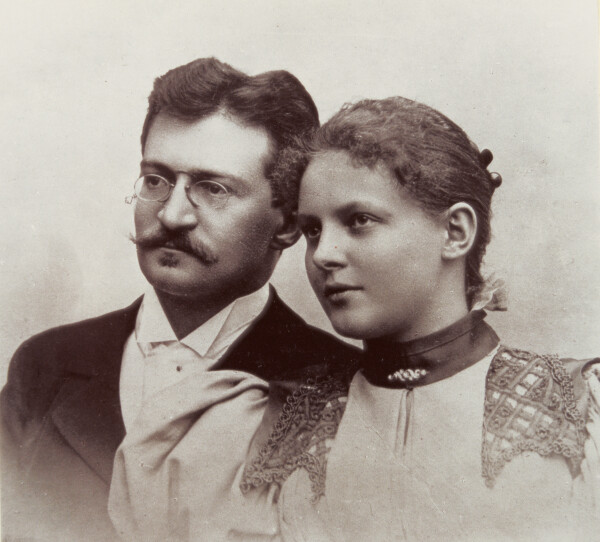The Primavesi Family

Otto and Eugenia Primavesi
© APA-PictureDesk
In the 1910s, Gustav Klimt maintained a close personal relationship with the art patrons Otto and Eugenia (Mäda) Primavesi. The long-standing financiers of the Wiener Werkstätte bought several paintings by Gustav Klimt.
The banker and industrial magnate Otto Primavesi and the actress Eugenia (Mäda) Primavesi married in 1894. The couple had four children, Leokadie (Lola), Eugenia (Mäda) jun., Melitta (Litta) and Otto jun. Until the end of World War I, the family lived in Ölmütz (now Olomouc, Czech Republic), where the family business, a banking house, was located.
The Primavesi Family and Gustav Klimt
In the 1910s, Gustav Klimt and the wealthy banking family became increasingly close. During World War I, the family repeatedly invited the artist to visit them at their new country estate in Winkelsdorf, which had been designed by Josef Hoffmann. There, they hosted legendary house parties for Christmas and New Year, attended by Gustav Klimt, which were documented in photographs. Aside from Klimt, the Primavesi family was also friends with Anton Hanak and their house’s architect Josef Hoffmann. Thus, the three artists often attended the parties together.

Gustav Klimt at a costume party in the cellar of the Primavesi family's country house in Winkelsdorf, presumably 12/30/1917-01/03/1918, Klimt Foundation
© Klimt Foundation, Vienna
Between 1912 and 1914, the family commissioned Klimt to portray the daughter Mäda Primavesi and Eugenia (Mäda) Primavesi. According to Mäda Primavesi, the two women regularly traveled to Vienna for their portrait sittings. In this context, Eugenia Primavesi wrote in a letter dated February 1913: “On the 18th, I am to sit again.” In the summer of 1913, Gustav Klimt wrote the family a receipt for the down payment on the two paintings in the amount of 15,000 crowns (approx. 83,800 euros). One of the paintings – likely Portrait of Eugenia (Mäda) Primavesi (1913/14, Toyota Municipal Museum of Art) – was completed by Klimt at Christmas 1913. The artist sent it via express train to Olmütz.

Letter from Fritz Waerndorfer in Vienna to Hermann Muthesius, 04/09/1906, Werkbundarchiv – Museum der Dinge: Letterhead of the Wiener Werkstätte, branch Neustiftgasse 32
© Werkbundarchiv - Museum der Dinge, Berlin
Viewing of Palais Stoclet
In 1914, the friends stayed together in Brussels. Accompanied by their close friend, the sculptor Anton Hanak, and the architect Josef Hoffmann, Otto and Eugenia Primavesi visited the Stoclet family, who had been hosting Gustav Klimt already for several days. In a letter to Emilie Flöge, dated 18 May 1914, the artist reported on their joint tour of the finished Palais Stoclet:
“Yesterday Hoffmann, the Primavesis and Hanak were here at the Stoclets’. They had come from Cologne via car […]. Frau Primavesi was rendered ‘speechless,’ as she told me, by the beauty of the house.”
Promoters of the Wiener Werkstätte
The Primavesis primarily acted as promoters and financial supporters of the Wiener Werkstätte. In 1914, they became shareholders of the company, which was experiencing financial difficulties. For serval years, Otto Primavesi himself acted as manager of the Wiener Werkstätte. In 1925, he left all his shares to his wife and died a year later. Five years later, Eugenia Primavesi, too, withdrew from the company.
Sale of the Collection
Likely on account of the Wiener Werkstätte’s unprofitable business, and the failure of their own banking house, the Primavesi family was forced to sell several paintings from their Klimt collection. These included the works Hope II (Vision) (1907/08, reworked: before 1914, The Museum of Modern Art, New York), Litzlbergkeller on the Attersee (1915/16, private collection) and Baby (1917/18 (unfinished), National Gallery of Art, Washington D.C.). This is documented, among other sources, by the catalogue accompanying the 1928 “Klimt-Gedächtnis-Ausstellung” [Exhibition in Commemoration of Klimt]. An exception is the portrait of Eugenia (Mäda) Primavesi. Eugenia bequeathed the likeness in 1962 to her daughter, who had emigrated to Canada after World War II. She then put the work up for auction in New York in 1987. Today, it is housed by the Municipal Museum of Art in Toyota.
Literature and sources
- Tobias G. Natter, Franz Smola, Peter Weinhäupl (Hg.): Klimt persönlich. Bilder – Briefe – Einblicke, Ausst.-Kat., Leopold Museum (Vienna), 24.02.2012–27.08.2012, Vienna 2012.
- Tobias G. Natter (Hg.): Gustav Klimt. Sämtliche Gemälde, Vienna 2012, S. 621-622, S. 624.
- Alfred Weidinger (Hg.): Gustav Klimt, Munich - Berlin - London - New York 2007, S. 296-297, S. 298.
- Tobias G. Natter (Hg.): Die Welt von Klimt, Schiele und Kokoschka. Sammler und Mäzene, Cologne 2003, S. 72-86.
- Felix Czeike (Hg.): Historisches Lexikon Wien, Band 5, Vienna 1997, S. 541.
- Carl Kraus: Mäda Primavesi, in: Tobias G. Natter (Hg.): Klimt and the Women of Vienna's Golden Age. 1900–1918, Ausst.-Kat., New Gallery New York (New York), 22.09.2016–16.01.2017, London - New York 2016, S. 102-111.
- Tobias G. Natter, Gerbert Frodl (Hg.): Klimt und die Frauen, Ausst.-Kat., Upper Belvedere (Vienna), 20.09.2000–07.01.2001, Cologne 2000, S. 126-129.
- Hedwig Steiner: Gustav Klimts Bindung an Familie Primavesi in Olmütz, in: Mährisch-Schlesische Heimat. Vierteljahresschrift für Kultur und Wirtschaft, Heft 4 (1968), S. 242-252.
- Claudia Klein-Primavesi: Die Familie Primavesi und die Künstler Hanak, Hoffmann, Klimt. 100 Jahre Wiener Werkstätte, Vienna 2004.





